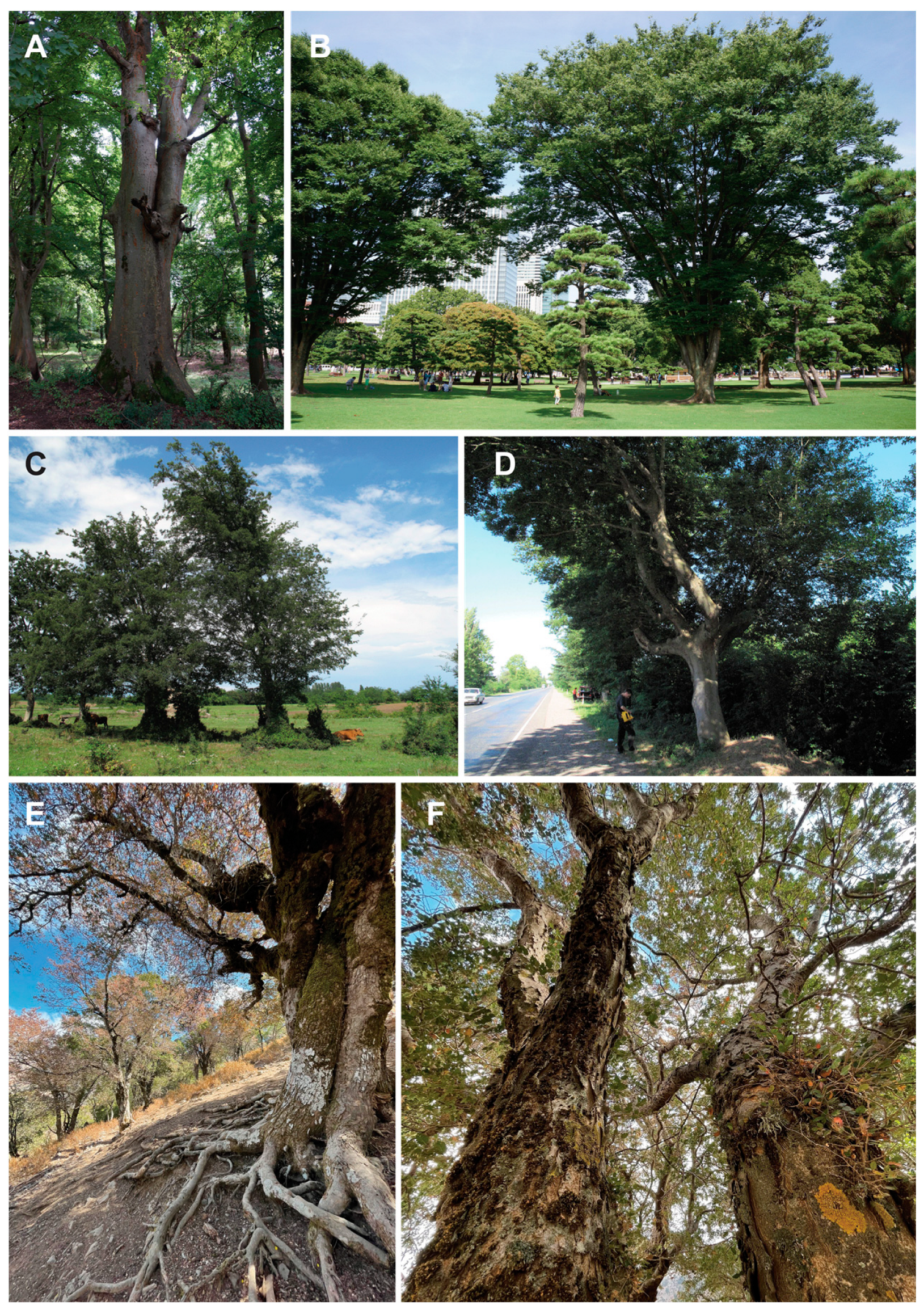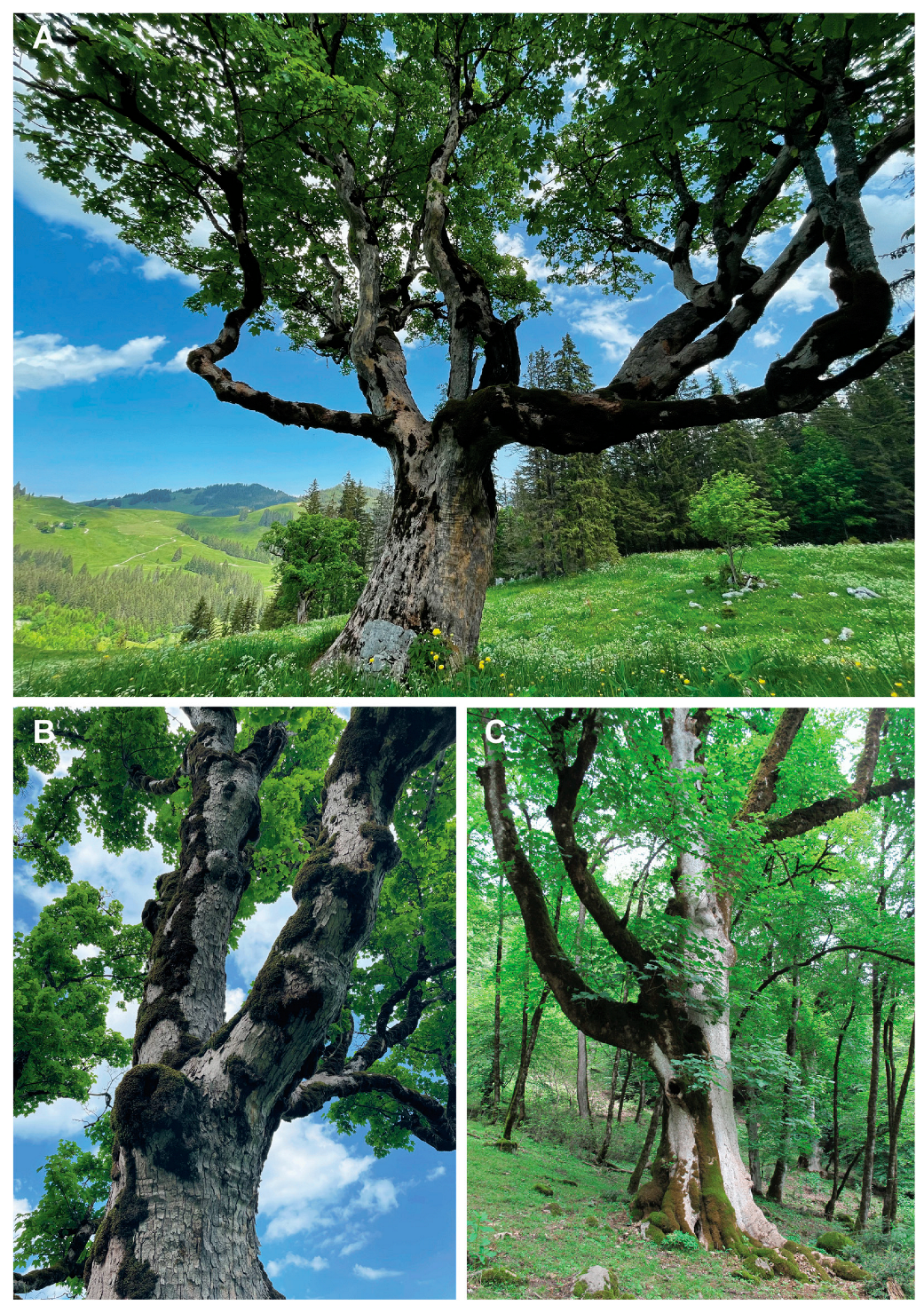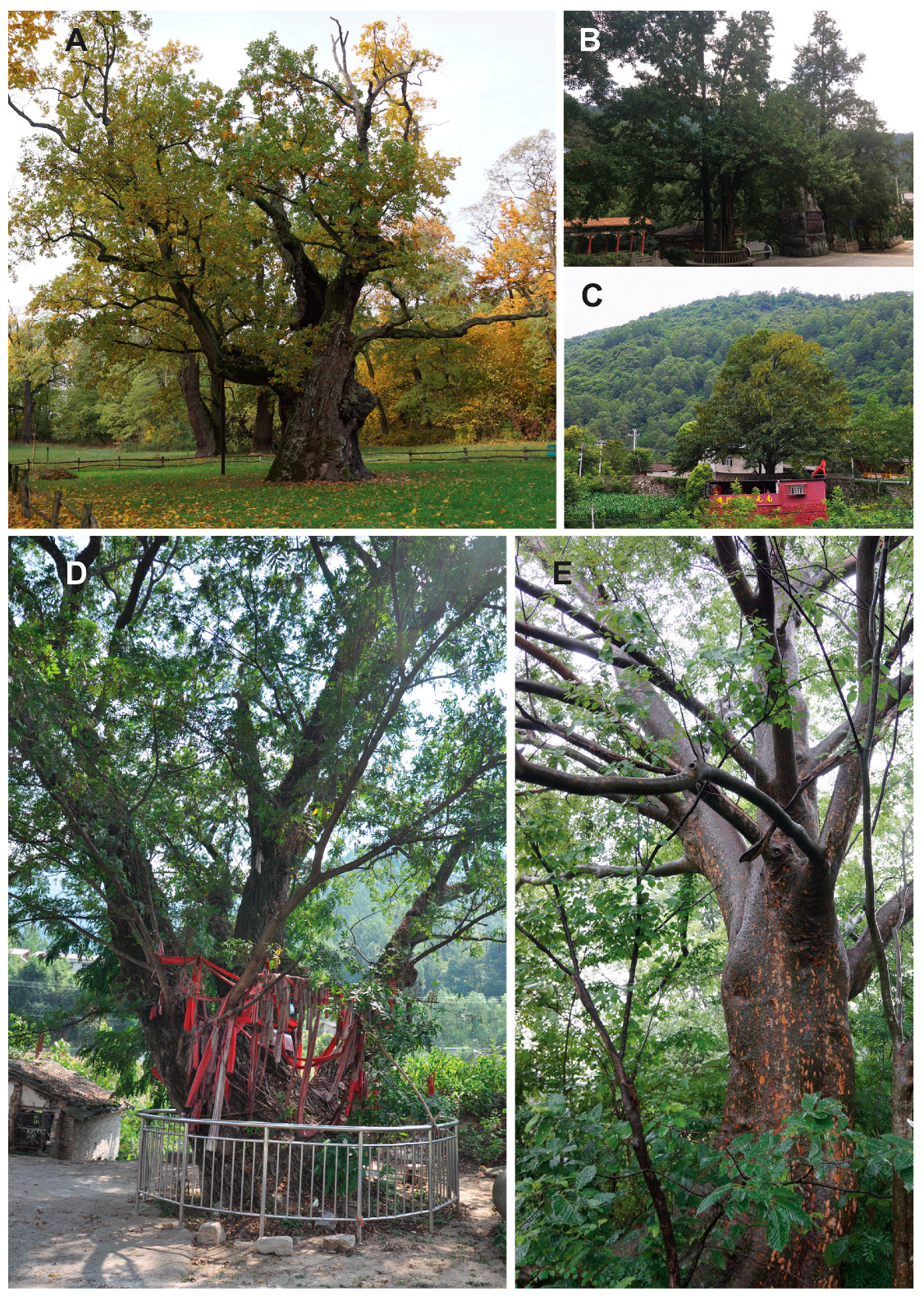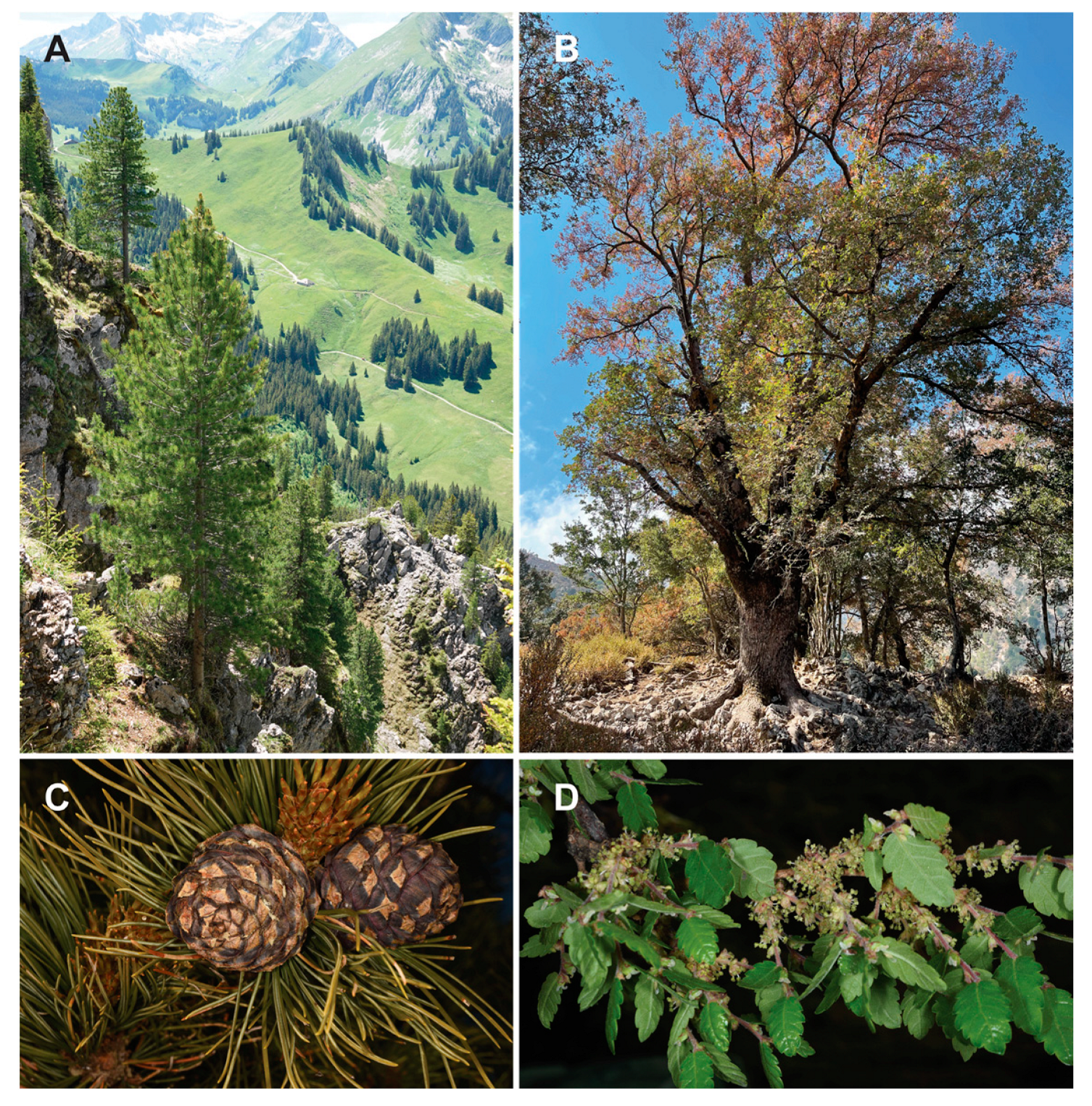Importance, Tools, and Challenges of Protecting Trees
Abstract
1. Introduction
2. Tree Versus Forest: Definitions and Typology
- Forest trees (Figure 1A and Figure 2C): These are multifunctional trees located in a forest and form an ecosystem with other plants and organisms. They have a triple ecological, economic, and social function. The protection of these trees is directly linked with the forestry law of a provided country or an administrative unit (e.g., governmental administration, ministry of environment, national park administration, etc.) [32,38].
- Trees outside forests (TOF): This term, coined in the 1990s, encompasses all trees that are not growing in a forested area [32]. They are often overlooked and undervalued, and they are not regularly included in local or national inventories and laws [40]. The following subcategories of TOF can be differentiated [27]:
- B.1.
- Urban trees (Figure 1B): They are distinguished from forest trees on the one hand because of their geographic location but also because of their tendency to monofunctionalism. In other words, they are trees with a monofunctional tendency located in the city or its periphery, planted or preserved as a result of a human decision with a social or an ecological aim (e.g., embellishment of cities, urban orchards, and fight against temperature rise and pollution). The protection of these trees has gained more attention in in recent decades and is largely organized by territorial planning (municipal council, administrations of cities, etc.) [41,42].
- B.2.
- Rural trees (Figure 1C and Figure 2A): Trees growing in a rural landscape. They are isolated trees or groups of trees located in agricultural areas and whose existence is linked to a human decision, exploited for the various products that can be obtained. However, unexploited isolated trees or tree groups that grow spontaneously and possess various ecological and social functions also belong to this category, e.g., hedges and landscape elements [43].
- B.3.
- Road trees (Figure 1D): Roadside trees, often forming road alleys, are multifunctional features usually planted to mark roads and paths. They possess various ecological (e.g., pollution control and corridors connecting habitats) and social functions (e.g., road layout, landscape elements, and educational value) [44,45]. Since multiple road authorities claim that tree-lined routes pose a threat to traffic safety, they are often a cause of conflict between the safety of humans and biodiversity protection [46].
- Monument trees (Figure 1E and Figure 3): This category transcends the four categories and subcategories listed above, in the sense that forest, urban, rural, or road trees can be classified as so-called landmarked, heritage, veteran, holy, or monument trees. Their protection is in certain countries and societies very ancient and has often been embodied in the law of environmental protection and nature conservation [47,48,49]. Each country possesses its own denomination and criteria in selecting such trees (e.g., in Germany “denkmalgeschützte Bäume”, in Poland “drzewa pomnikowe” and in France “arbre remarquables”). One of the criteria can be the rarity, endemism, or conservation status of a provided tree species. More often, however, monument trees are selected due to their dimension, age, or spiritual value [20,29,31,50,51,52,53]. This category also encompasses small groups of old trees or preserved small patches of forest, such as sacred groves, remnants of ancient traditions and pagan religions in Europe [23], or fengshui woods in China (Figure 3E) [54,55].
- Habitat trees (Figure 1F and Figure 2B): This category also transcends the categories and subcategories listed above. A habitat tree is a living or dead standing tree that bears at least one microhabitat [39]. Tree-related microhabitats (abbreviated as TreMs) are very small-scale or specially delimited habitats supported by the individual tree. Thousands of different, sometimes highly specialized, animal, plant, lichen, and fungal species depend for at least part of their life cycle on these structures [14,56]. Although the concept of habitat trees was developed nearly 200 years ago [49], this category has only recently been officially recognized in several European countries and is an object of national or local laws and regulations (e.g., in Germany, Switzerland, France, etc.) [39].
3. Tools and Initiatives for the Protection of Trees
3.1. International Initiatives
3.2. International Conventions and Agreements
3.3. Red Lists
3.4. Lists of Protected Species
3.5. Monument Trees
3.6. Trees as Legal Persons
4. Challenges of Tree Protection
4.1. Large Number of Tree Species
4.2. Large Number of Threatened Tree Species
4.3. Protection of Forest Trees
4.4. Protection of Trees Outside Forests
5. Conclusions
Author Contributions
Funding
Acknowledgments
Conflicts of Interest
References
- Fazan, L.; Song, Y.-G.; Kozlowski, G. The woody planet: From past triumph to manmade decline. Plants 2020, 9, 1593. [Google Scholar] [CrossRef]
- Balding, M.; Williams, J.H. Plant blindness and the implications for plant conservation. Conserv. Biol. 2016, 30, 1192–1199. [Google Scholar] [CrossRef]
- BGCI. State of the World’s Trees; Botanic Gardens Conservation International: Richmond, UK, 2021. [Google Scholar]
- Cronk, Q.C.B.; Forest, F. The evolution of angiosperm trees: From palaeobotany to genomics. In Comparative and Evolutionary Genomics of Angiosperm Trees; Springer: Berlin/Heidelberg, Germany, 2017. [Google Scholar]
- Gerrienne, P.; Gensel, P.G.; Strullu-Derrien, C.; Lardeux, H.; Steemans, P.; Prestianni, C. A simple type of wood in two early Devonian plants. Science 2011, 333, 837. [Google Scholar] [CrossRef]
- Meyer-Berthaud, B.; Scheckler, S.E.; Wendt, J. Archaeopteris is the earliest known modern tree. Nature 1999, 398, 700–701. [Google Scholar] [CrossRef]
- Stein, W.E.; Mannolini, F.; Van Aller Hernick, L.; Landing, E.; Berry, C.M. Giant cladoxylopsid trees resolve the enigma of the Earth’s earliest forest stumps at Gilboa. Nature 2007, 446, 904–907. [Google Scholar] [CrossRef]
- FitzJohn, R.G.; Pennell, M.E.; Zanne, A.M.; Stevens, P.F.; Tank, D.C.; Cornwell, W.K. How much of the world is woody? J. Ecol. 2014, 102, 1266–1272. [Google Scholar] [CrossRef]
- Beech, E.; Rivers, M.; Oldfield, S.; Smith, P.P. Global Tree Search: The first complete global database of tree species and country distributions. J. Sustain. Forest. 2017, 36, 454–489. [Google Scholar] [CrossRef]
- Cazzolla Gatti, R.; Reich, P.B.; Gamarra, J.G.; Crowther, T.; Hui, C.; Morera, A.; Bastin, J.-F.; de-Miguel, S.; Nabuurs, G.-J.; Liang, J.; et al. The number of tree species on Earth. Proc. Natl. Acad. Sci. USA 2022, 119, e2115329119. [Google Scholar] [CrossRef]
- Bar-On, Y.M.; Phillips, R.; Milo, R. The biomass distribution on Earth. Proc. Natl. Acad. Sci. USA 2018, 115, 6506–6511. [Google Scholar] [CrossRef]
- Mitchell, R.J.; Bellamy, P.E.; Ellis, C.J.; Hewins, R.L.; Hodgetts, N.G.; Iason, G.R.; Littlewood, N.A.; Newey, S.; Stockan, J.A.; Taylor, A.F.S. Collapsing foundations: The ecology of the British oak, implications of its decline and mitigation options. Biol. Conserv. 2019, 233, 316–327. [Google Scholar] [CrossRef]
- Fazan, L.; Gwiazdowicz, D.J.; Fragnière, Y.; Faltynowicz, W.; Ghosn, D.; Remoundou, I.; Rusinska, A.; Urbanski, P.; Pasta, S.; Garfi, G.; et al. Relict trees as habitat: Factors influencing diversity and distribution of epiphytic lichens and bryophytes of Zelkova abelicea (Ulmaceae) on Crete. Lichenologist 2022, 54, 199–212. [Google Scholar] [CrossRef]
- Gwiazdowicz, D.J.; Skarzynski, D.; Fazan, L.; Fragnière, Y.; Ghosn, D.; Kozlowski, G.; Kuzminski, R.; Remoundou, I.; Zawieja, B. Microarthropods living on the endemic tree Zelkova abelicea (Ulmaceae) with particular attention to Cellembola diversity. Forests 2022, 13, 195. [Google Scholar] [CrossRef]
- Kozlowski, G.; Gratzfeld, J. Zelkova-an Ancient Tree. Global Status and Conservation Action; Natural History Museum Fribourg: Fribourg, Switzerland, 2012. [Google Scholar]
- Kozlowski, G.; Bétrisey, S.; Song, Y.-G.; Fazan, L.; Garfi, G. The Red List of Zelkova; Natural History Museum Fribourg: Fribourg, Switzerland, 2018. [Google Scholar]
- Kozlowski, G.; Bétrisey, S.; Song, Y.-G. Wingnuts (Pterocarya) and Walnut Family. Relict Trees: Linking the Past, Present and Future; Natural History Museum Fribourg: Fribourg, Switzerland, 2018. [Google Scholar]
- Kozlowski, E.; Kozlowski, G. The Green Heart of Our Planet. A Journey through the World of Trees; Forest Culture Center in Goluchow: Goluchow, Poland, 2021. [Google Scholar]
- Aisling, I. No tree left behind. Nature 2022, 609, 24–27. [Google Scholar]
- Jim, C.Y. Monitoring the performance and decline of heritage trees in urban Hong Kong. J. Environ. Manag. 2005, 74, 161–172. [Google Scholar] [CrossRef] [PubMed]
- Vest, J.H.C. Will-of-the-land: Wilderness among primal Indo-Europeans. Environ. Rev. 1985, 9, 323–329. [Google Scholar] [CrossRef]
- Dumont, D.J. The ash tree in Indo-European culture. Mankind Quart. 1992, 32, 323–336. [Google Scholar] [CrossRef]
- Cusack, C.M. The Sacred Tree: Ancient and Medieval Manifestations; Cambridge Scholars Publishing: Cambridge, UK, 2011. [Google Scholar]
- Arnold, C.; Atchison, J.; McKnight, A. Reciprocal relationships with trees: Rekindling Indigenous wellbeing and identity through the Yuin ontology of oneness. Aust. Geogr. 2021, 52, 131–147. [Google Scholar] [CrossRef]
- Cannon, C.H.; Piovesan, G.; Munné-Bosch, S. Old and ancient trees are life history lottery winners and vital evolutionary resources for long-term adaptive capacity. Nat. Plants 2022, 8, 136–145. [Google Scholar] [CrossRef] [PubMed]
- Kazmierska-Patrzyczna, A. Instrumenty prawne ochrony drzew i krzewow. Acta Univ. Lodz. 2012, 71, 21–33. [Google Scholar]
- Eude, M. Du Droit de L’arbre. Pour la Protection Fonctionelle; RDLF 2021, Thèse no 07; Université Toulouse I: Toulouse, France, 2021. [Google Scholar]
- Lindenmayer, D.B.; Laurence, W.F.; Franklin, J.F. Global decline in large old trees. Science 2012, 338, 1305–1306. [Google Scholar] [CrossRef] [PubMed]
- Lindenmayer, D.B.; Laurence, W.F. The unique challenges of conserving large old trees. Trends Ecol. Evol. 2016, 31, 416–418. [Google Scholar] [CrossRef]
- Henwood, K.; Pidgeon, N. Talk about woods and trees: Threat of urbanization, stability, and biodiversity. J. Environ. Psychol. 2001, 21, 125–147. [Google Scholar] [CrossRef]
- Blicharska, M.; Mikusinski, G. Incorporating social and cultural significance of large old trees in conservation policy. Conserv. Biol. 2014, 28, 1558–1567. [Google Scholar] [CrossRef]
- Bellefontaine, R.; Petit, S.; Pain-Orcet, M.; Deleporte, P.; Bertault, J.-G.; Trees Outside Forests. Towards a Better Awareness. In FAO Conservation Guide No 35; 2002. Available online: https://www.fao.org/3/y2328e/y2328e00.htm#toc (accessed on 20 February 2022).
- Lindenmayer, D.B.; Laurence, W.F.; Franklin, J.F.; Likens, G.E.; Banks, S.C.; Blanchard, W.; Gibbson, P.; Ikin, K.; Blair, D.; McBurney, L.; et al. New policies for old trees: Averting a global crisis in a keystone ecological structure. Conserv. Lett. 2014, 7, 61–69. [Google Scholar] [CrossRef]
- Global Tree Assessment (GTA). Available online: https://www.globaltreeassessment.org (accessed on 20 February 2022).
- Forest Resources Assessment. Terms and Definitions. In Forest Resources Assessment Working Paper 180; Forest Resources Assessment: Rome, Italy, 2015. [Google Scholar]
- Gesetz zur Erahltung des Waldes und zur Förderung der Forstwirtschaft (BWaldG, Bundeswalggesetz). Available online: https://www.gesetze-im-internet.de/bwaldg/BWaldG.pdf (accessed on 20 February 2022).
- Forest Law of the People’s Republic of China. Available online: http://www.npc.gov.cn/englishnpc/c23934/202012/170ad07d186b4a2ab6b7fac21e57f69e.shtml (accessed on 20 February 2022).
- Swiss Environmental Law. A Brief Guide; Federal Office for the Environment: Bern, Switzerland, 2013. [Google Scholar]
- Bütler, R.; Lachat, T.; Krumm, F.; Kraus, D.; Larrieu, L. Know, protect and promote habitat trees. Swiss Federal Institute WSL. WSL Fact Sheet 2021, 64, 1–12. [Google Scholar]
- Thomas, N.; Baltezar, P.; Lagomasimo, D.; Stovali, A.; Iqbal, Z.; Fatoyinbo, L. Trees outside forests are an underestimated resource in a country with low forest cover. Sci. Rep. 2021, 11, 7919. [Google Scholar] [CrossRef]
- Profus, G.V.; Loeb, R.E. The legal protection of urban trees: A comparative world survey. J. Environ. Law 1990, 2, 179–193. [Google Scholar] [CrossRef]
- Emmet Jones, R.; Davis, K.L.; Bradford, J. The value of trees: Factors influencing homeowner support for protecting local urban trees. Environ. Behav. 2012, 45, 650–676. [Google Scholar] [CrossRef]
- Percival, G.; Schaffert, E.; Hailey, L. Trees in the rural landscape. In Horticulture: Plants for People and Place; Springer: Berlin, Germany, 2014; Volume 2, pp. 713–730. [Google Scholar]
- Ozdemir, H. Mitigation impact of roadside trees on fine particle pollution. Sci. Total Environ. 2019, 659, 1176–1185. [Google Scholar] [CrossRef]
- Sanchez, J.M.P.; Teologo, A.L.M.I.; Villamejor, R.R.; Britzel, G.; Rieta, T.; Oberes, J.S.; Romeo, J.O.; Pahamotang, Z.A.; Gempisao, S.A.; Villarojo, L.E. Educational value of roadside trees in Carcar city, Cebu, Philippines: Implications to environmental education. Biosaintifika 2021, 13, 345–355. [Google Scholar] [CrossRef]
- Suchocka, M.; Blaszczyk, M.; Juzwiak, A.; Duriasz, J.; Bohdan, A.; Stolarczyk, J. Transit versus nature. Depreciation of environmental values of the road alleys. Case study: Gamerki-Jonkowo, Poland. Sustainibility 2019, 11, 1816. [Google Scholar] [CrossRef]
- Pietrzak-Zawadka, J. Protection of trees–monuments of nature in selected European countries. In Zarządzanie Ochroną Przyrody w Lasach; Bialystok University of Technology: Hajnowka, Poland, 2016. [Google Scholar] [CrossRef]
- Touzé, O. La Protection Juridique des Arbres Remarquables. Master Thesis, UFR de Rouen, Faculté de Droit, Sciences Economiques et Gestion, Rouen, France, 2019. [Google Scholar]
- Mölder, A.; Schmidt, M.; Plieniger, T.; Meyer, P. Habitat-tree protection concepts over 200 years. Conserv. Biol. 2020, 34, 1444–1451. [Google Scholar] [CrossRef] [PubMed]
- Mikusinski, G.; Bubnicki, J.W.; Churski, M.; Czeszczewik, D.; Walankiewicz, W.; Kuijper, D.P.J. Is the impact of loggings in the last primeval lowland forest in Europe underestimated? The conservation issues of Bialowieza Forest. Biol. Conserv. 2018, 227, 266–274. [Google Scholar] [CrossRef]
- Lindenmayer, D.B. Conserving large old trees as small natural features. Biol. Conserv. 2017, 211, 51–59. [Google Scholar] [CrossRef]
- Lindenmayer, D.B.; Laurence, W.F. The ecology, distribution, conservation and management of large old trees. Biol. Rev. 2017, 92, 1434–1458. [Google Scholar] [CrossRef]
- Liu, J.; Lindenmayer, D.B.; Yang, W.; Ren, Y.; Campbell, M.J.; Wu, C.; Luo, Y.; Zhong, L.; Yu, M. Diversity and density patterns of large old trees in China. Sci. Total Environ. 2019, 655, 255–262. [Google Scholar] [CrossRef]
- Gao, H.; Ouyang, Z.; Chen, S.; van Koppen, C.S.A. Role of culturally protected forests in biodiversity conservation in Southeast China. Biodiv. Conserv. 2013, 22, 531–544. [Google Scholar] [CrossRef]
- Chen, B.; Coggis, C.; Minor, J.; Zhang, Y. Fengshui forests and village landscape in China: Geographic extent, socioecological significance, and conservation prospects. Urban For. Urban Gree. 2018, 31, 79–92. [Google Scholar] [CrossRef]
- Larrieu, L.; Paillet, Y.; Winter, S.; Bütler, R.; Kraus, D.; Krumm, F.; Lachat, T.; Michel, A.K.; Regnery, B.; Vanderkerkhove, K. Tree related microhabitats in temperate and Mediterranean European forests: A hierarchical typology for inventory standardization. Ecol. Indic. 2018, 84, 194–207. [Google Scholar] [CrossRef]
- Global Trees Campaign (GTC). Available online: https:////globaltrees.org (accessed on 15 February 2022).
- Fauna and Flora International (FFI). Available online: https://www.fauna-flora.org (accessed on 15 February 2022).
- Botanic Gardens Conservation International (BGCI). Available online: https://www.bgci.org (accessed on 12 February 2022).
- Global Conservation Consortia (GCC). Available online: https://www.globalconservationconsortia.org (accessed on 12 February 2022).
- IUCN Species Survival Commission (SSC). Available online: https://www.iucn.org/commissions/species-survival-commission (accessed on 15 February 2022).
- IUCN/SSC Global Tree Specialist Group (GTCG). Available online: https://globaltrees.org/iucn-ssc-global-tree-specialist-group/ (accessed on 15 February 2022).
- Project Zelkova of the Botanic Garden of the University of Fribourg (Switzerland). Available online: https://www.zelkova.ch (accessed on 10 February 2022).
- Fazan, L.; Ghosn, D.; Remoundou, I.; Gotsiou, P.; Thanos, C.; Pasta, S.; Garfi, G.; Kozlowski, G. Free behind bars: Effects of browsing exclusion on the growth and regeneration of Zelkova abelicea. Forest Ecol. Manag. 2021, 488, 118967. [Google Scholar] [CrossRef]
- Fragnière, Y.; Song, Y.-G.; Fazan, L.; Manchester, S.; Garfi, G.; Kozlowski, G. Biogeographic overview of Ulmaceae: Diversity, distribution, climatic and ecological preferences. Plants 2021, 10, 1111. [Google Scholar] [CrossRef]
- Fragnière, Y.; Sonnenwyl, V.; Clément, B.; Kozlowski, G. Large-scale historical afforestation failure with Pinus cembra in the Swiss Prealps. New For. 2021, 53, 533–553. [Google Scholar] [CrossRef]
- Song, Y.-G.; Fragnière, Y.; Meng, H.-H.; Li, Y.; Bétrisey, S.; Corrales, A.; Manchester, S.; Deng, M.; Jasinska, A.; Van Sam, H.; et al. Global biogeographic synthesis and priority conservation regions of the relict tree family Juglandaceae. J. Biogeogr. 2020, 47, 643–657. [Google Scholar] [CrossRef]
- Song, Y.-G.; Li, Y.; Meng, H.-H.; Fragnière, Y.; Ge, B.-J.; Sakio, H.; Yousefzadeh, H.; Bétrisey, S.; Deng, M.; Kozlowski, G. Phylogeny, species delimitation and biogeography of the relict tree genus Pterocarya (Juglandaceae). Plants 2020, 9, 1524. [Google Scholar] [CrossRef]
- Wang, T.-R.; Wang, Z.-W.; Song, Y.-G.; Kozlowski, G. The complete chloroplast genome sequence of Quercus ningangensis and its phylogenetic implication. Plant Fungal Syst. 2021, 66, 155–165. [Google Scholar] [CrossRef]
- Convention on Biological Diversity (CBD). Available online: https://www.cbd.int (accessed on 12 February 2022).
- Convention on International Trade in Endangered Species of Wild Fauna and Flora (CITES). Available online: https://cites.org/eng (accessed on 12 February 2022).
- Grover, M.; Ruthefored, C. CITES and Timber. A Guide to CITES-Listed Tree Species; Royal Botanic Gardens, Kew: London, UK, 2015. [Google Scholar]
- International Union for Conservation of Nature (IUCN). Available online: www.iucn.org (accessed on 20 February 2022).
- Red List of Threatened Species (IUCN Red List). Available online: https://www.iucnredlist.org (accessed on 10 February 2022).
- Rodrigues, A.S.L.; Pilgrim, J.D.; Lamoreux, J.F.; Hoffmann, M.; Brooks, T.M. The value of the IUCN Red List for conservation. Trends Ecol. Evol. 2006, 21, 71–76. [Google Scholar] [CrossRef]
- Bornand, C.; Eggenberg, S.; Gygax, A.; Juillerat, P.; Jutzi, M.; Möhl, A.; Rometsch, S.; Sager, L.; Santiago, H. Rote Liste Gefässpflanzen. In Gefährdete Arten der Schweiz; Bundesamt für Umwelt BAFU: Bern, Switzerland, 2016. [Google Scholar]
- Mombrial, F.; Chevalier, M.; Favre, E.; Lacroix, A.; Sandoz, E.; Sandoz, F.; Tribot, S. Liste Rouge des plantes vasculaires de Genève; Conservatoire et Jardin Botanique Ville de Genève Hors-Série; Conservatoire et Jardin botaniques de la ville de Genève: Geneva, Switzerland, 2020; Volume 20, pp. 1–111. [Google Scholar]
- Rivers, M.C.; Beech, E.; Bazos, I.; Bogunić, F.; Buira, A.; Caković, D.; Carapeto, A.; Carta, A.; Cornier, B.; Fenu, G.; et al. European Red List of Trees; IUCN: Cambridge, UK, 2019. [Google Scholar]
- Silva, S.V.; Andermann, T.; Zizka, A.; Kozlowski, G.; Silvestro, D. Global estimation and mapping of the conservation status of tree species using artificial intelligence. Front. Plant Sci. 2022, 13, 839792. [Google Scholar] [CrossRef]
- Gibbs, D.; Chen, Y. The Red List of Maples; Botanic Garden Conservation International (BGCI): Surrey, UK, 2009. [Google Scholar]
- Carrero, C.; Jerome, D.; Beckman, E.; Byrne, A.; Coombes, A.J.; Deng, M.; González-Rodríguez, A.; Hoang, V.S.; Khoo, E.; Nguyen, N.; et al. The Red List of Oaks 2020; The Morton Arboretum: Lisle, IL, USA, 2020. [Google Scholar]
- Shaw, K.; Stritch, L.; Rivers, M.; Roy, S.; Wilson, B.; Govaerts, R. The Red List of Betulaceae; Botanic Gardens Conservation International: Richmond, UK, 2020. [Google Scholar]
- Vivero, J.L.; Szejner, M.; Gordon, J.; Magin, G. The Red List of Trees of Guatemala; Fauna & Flora Intenantional: Cambridge, UK, 2006. [Google Scholar]
- Beech, E.; Rivers, M.; Rabarimanarivo, M.; Ravololomanana, N.; Manjato, N.; Lantoarisoa, F.; Andriambololonera, S.; Ramandimbisoa, B.; Ralimanana, H.; Rakotoarisoa, S.; et al. Red List of Trees of Madagascar; BGCI: Richmond, UK, 2021. [Google Scholar]
- Convention on the Conservation of European Wildlife and Natural Habitats (Ben Convention). Available online: https://www.coe.int/en (accessed on 15 February 2022).
- Arrêté Concernant la Protection de la Faune et de la Flore Fribourgeoise du 12.03.1973. Available online: https://www.lexfind.ch/tolv/22722/fr (accessed on 15 February 2022).
- Kozlowski, G.; Frey, D.; Fazan, L.; Egli, B.; Bétrisey, S.; Gratzfeld, J.; Garfi, G.; Pirintsos, S. Tertiary relict tree Zelkova abelicea Ulmaecae): Distribution, population structure and conservation status. Oryx 2014, 48, 80–87. [Google Scholar] [CrossRef][Green Version]
- Kozlowski, G.; Frey, D.; Fazan, L.; Egli, B.; Pirintsos, S. Zelkova abelicea. In IUCN 2012. IUCN Red List of Threatened Species. Version 2012.2. 2012. Available online: www.iucnredlist.org (accessed on 15 February 2022).
- European Union-Council Directive 92/43/EEC of 21 May 1992 on the Conservation of Natural Habitats and of Wild Fauna and Flora. Available online: https://eur-lex.europa.eu/legal-content/EN/TXT/?uri=CELEX%3A31992L0043 (accessed on 15 February 2022).
- Zhou, Z.H.; Jin, X.H. Analysis and suggestions on policies and regulations on conservation and management of wild plants in China. Biodivers. Sci. 2021, 29, 1583–1590. [Google Scholar] [CrossRef]
- Lu, Z.L.; Qin, H.N.; Jin, X.H.; Zhang, Z.X.; Yang, Q.W.; Hong, D.Y.; Li, D.Z.; Li, K.F.; Yuan, L.C.; Zhou, Z.H. On the necessity, principle and process of updating the List of National Key Protected Wild Plants. Biodivers. Sci. 2021, 29, 1577–1582. [Google Scholar] [CrossRef]
- Ordinance on the Protection of Nature and Cultural Heritage (NCHO). Available online: https://fedlex.data.admin.ch/filestore/fedlex.data.admin.ch/eli/cc/1991/249_249_249/20150301/en/pdf-a/fedlex-data-admin-ch-eli-cc-1991-249_249_249-20150301-en-pdf-a.pdf (accessed on 10 February 2022).
- Arrêté Concernant la Protection de la Flore de la République et Canton de Neuchâtel su 24.02.1965. Available online: https://rsn.ne.ch/DATA/program/books/RSN2010/20102/pdf/461105.pdf (accessed on 10 February 2022).
- UNESCO World Heritage Convention. Available online: https://whc.unesco.org/en/convention/ (accessed on 10 February 2022).
- Ustawa o ochronie przyrodyz dnia 16 kwietnia 2004. Available online: https://lexlege.pl/ustawa-o-ochronie-przyrody/ (accessed on 10 February 2022).
- Pietrzak-Zawadka, J. Problemy ochrony drzew I krzewow pomnikowych w Polsce. In Zarządzanie Ochroną Przyrody w Lasach; 2010; Available online: http://agro.icm.edu.pl/agro/element/bwmeta1.element.agro-73fc7bfd-0aae-4e45-8653-586d81545b5e (accessed on 10 February 2022).
- Gesetz über Naturschutz und Landschaftspflege (Bundesnaturschutzgesetzt-BnatSchG) vom 20.12.1976. Available online: https://dejure.org/BGBl/1976/BGBl._I_S._3573 (accessed on 15 February 2022).
- Czech National Council Act No. 114/92 on the Protection of Nature and the Landscape of 1992. Available online: https://www.ecolex.org/details/legislation/czech-national-council-act-no-11492-on-the-protection-of-nature-and-the-landscape-lex-faoc004729/ (accessed on 15 February 2022).
- Office of the National Greening Council. Protection status and countermeasures of ancient and famous trees in China. Land Virescence 2005, 10, 6–8. [Google Scholar]
- Stone, C.D. Should trees have standing? Towards legal rights for natural objects. South. Calif. Law Rev. 1972, 45, 450–501. [Google Scholar]
- Bertenthal, A. Standing up for trees: Rethinking representation in a multispecies context. Law Lit. 2019, 32, 355–373. [Google Scholar] [CrossRef]
- Davies, M. The consciousness of trees. Law Lit. 2015, 27, 217–235. [Google Scholar] [CrossRef]
- Kramm, M. When river becomes a person. J. Hum. Dev. Capabil. 2020, 21, 307–319. [Google Scholar] [CrossRef]
- Eckstein, G.; D’Andrea, A.; Marshall, V.; O’Donnell, E.; Talbot-Jones, J.; Curran, D.; O’Bryan, K. Conferring legal personality on the world’s rivers: A brief intellectual assessment. Water Int. 2019, 44, 804–829. [Google Scholar] [CrossRef]
- Kozlowski, G. Is the global conservation status assessment of a threatened taxon a utopia? Biodivers. Conserv. 2008, 17, 445–448. [Google Scholar] [CrossRef][Green Version]
- Brown, J.H.; Lomolino, M.V. Biogeography; Sinauer Press: Sunderland, MA, USA, 1998. [Google Scholar]
- Marris, E. The species and the specious. Nature 2007, 446, 250–253. [Google Scholar] [CrossRef]
- Lomolino, M.V.; Heaney, L.R. Frontiers of Biogeography: New Directions in the Geography of Nature; Sinauer Associates: Sunderland, MA, USA, 2004. [Google Scholar]
- Bezemer, N.; Krauss, S.L.; Roberts, D.G.; Hopper, S.D. Conservation of old individual trees and small populations is intergral to maintain species’ genetic diversity of a historically fragmented woody perennial. Mol. Ecol. 2019, 28, 3339–3357. [Google Scholar] [CrossRef]
- Exposito-Alonso, M.; Booker, T.R.; Czch, L.; Gillespie, L.; Hateley, S.; Kyriazis, C.C.; Lang, P.L.M.; Leventhal, L.; Nogues-Bravo, D.; Pagowski, V.; et al. Genetic diversity loss in the Anthropocene. Science 2022, 377, 1431–1435. [Google Scholar] [CrossRef]




Publisher’s Note: MDPI stays neutral with regard to jurisdictional claims in published maps and institutional affiliations. |
© 2022 by the authors. Licensee MDPI, Basel, Switzerland. This article is an open access article distributed under the terms and conditions of the Creative Commons Attribution (CC BY) license (https://creativecommons.org/licenses/by/4.0/).
Share and Cite
Kozlowski, G.; Song, Y.-G. Importance, Tools, and Challenges of Protecting Trees. Sustainability 2022, 14, 13107. https://doi.org/10.3390/su142013107
Kozlowski G, Song Y-G. Importance, Tools, and Challenges of Protecting Trees. Sustainability. 2022; 14(20):13107. https://doi.org/10.3390/su142013107
Chicago/Turabian StyleKozlowski, Gregor, and Yi-Gang Song. 2022. "Importance, Tools, and Challenges of Protecting Trees" Sustainability 14, no. 20: 13107. https://doi.org/10.3390/su142013107
APA StyleKozlowski, G., & Song, Y.-G. (2022). Importance, Tools, and Challenges of Protecting Trees. Sustainability, 14(20), 13107. https://doi.org/10.3390/su142013107






